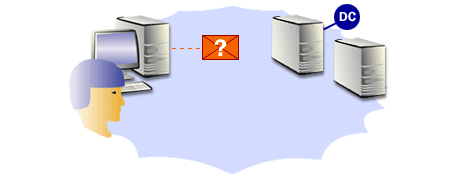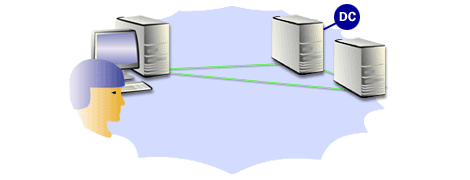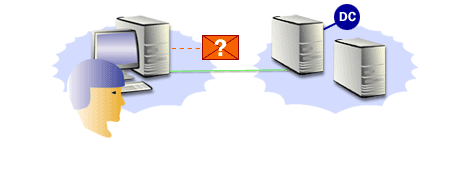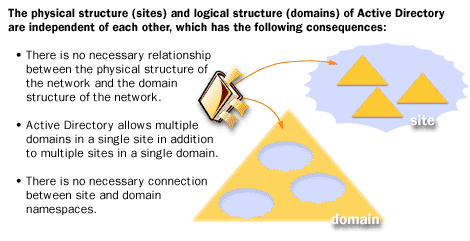| Lesson 3 | Sites |
| Objective | Define Sites and their role in reducing network traffic. |
Reducing Active Directory Network Traffic
Active Directory Sites can reduce network traffic by providing a way to logically group computers and other network resources based on their physical location. By doing so, Active Directory can route authentication and replication traffic within a site, rather than over a wide area network (WAN) connection to a remote site. This helps to reduce network traffic and improve network performance by minimizing the amount of data that needs to be transmitted over WAN connections. For example, if a user logs in to a computer at a site, Active Directory can authenticate the user locally, rather than transmitting authentication traffic over a WAN connection to a remote site. Additionally, Active Directory Sites can be configured with replication schedules and bandwidth throttling to further reduce network traffic. Replication schedules allow administrators to control when replication traffic occurs, so that it can be scheduled for off-peak hours when network traffic is lighter. Bandwidth throttling allows administrators to limit the amount of network bandwidth that is used for replication traffic, ensuring that other network traffic is not impacted. Overall, Active Directory Sites provide a powerful way to optimize network traffic and improve network performance in a distributed environment. By logically grouping resources based on physical location and controlling the flow of traffic between sites, administrators can ensure that network traffic is efficiently managed and network performance is optimized.
Sites Role in reducing Network Traffic
A site[1] is a combination of one or more Internet Protocol (IP) subnets connected by a high-speed link. By defining a site, you reduce replication traffic across slower links. Staying within the same site decreases traffic between domain controllers, which means that the network replication is more efficient. Note that traffic between domain controllers is a problem with replication. With logon authentication, the traffic is between client computers and a domain controller. Either situation can cause network congestion when taking place across a slow wide area network (WAN) link. Workstation logon and replication causes increased Active Directory traffic. To address this, you must ensure that Windows 2000 uses the most efficient links and schedules for replication and logon. Note that sites are used only when a network spans multiple geographic locations that are connected by slow links. Defining sites is of no use on a local area network that is contained at one physical location.
- Logon Request Validation Process:
A workstation logon request is validated more or less efficiently, depending on whether the request is validated by a local domain controller, or one outside the site. Put another way, the user logon request is most efficiently validated by the domain controller closest to it. When the local domain controller initiates replication for a naming context with one of its partners, the highest USN for that partner from the domain controller's highwatermark vector for the naming context is one of the pieces of information sent to the replication partner. The replication partner compares that value with its current highest USN for the naming context to help determine what changes should be sent to the domain controller. This logic is further refined by the up-to-dateness vector, as described in the next section. - Up-to-dateness Vector:
The (UTDV) up-to-dateness vector is a table maintained independently by every domain controller to assist in efficient replication of a naming context. Specifically, it is used for replication dampening to reduce needless replication traffic and endless replication loops. There is one table for every naming context the domain controller maintains a replica of, at a minimum, every domain controller will have at least three of these tables. Each table stores the highest originating update USN the domain controller has received from every other domain controller that has ever existed in the forest, as well as the date/time at which the domain controller last successfully completed a replication cycle with the given replication partner and naming context. The up-to-dateness vector is used in conjunction with the high-watermark vector to reduce replication traffic. When the replication request for a naming context is passed to the replication partner, the destination domain controller's up-to-dateness vector for the naming context is also in the request. The source partner can then zero in on changes that it has not previously sent and then further filter out any changes that the destination may have already received from other replication partners. In this way, it guarantees that a single change is not replicated to the same domain controller multiple times; this is called propagation dampening.
Writable Domain Controller
An RODC is a new type of domain controller that hosts read-only partitions of the Active Directory database. Except for account passwords, an RODC holds all the Active Directory objects and attributes that a writable domain controller holds. However, changes can't be made to the database that is stored on the RODC. Windows Server 2008 introduced the ability to start and stop Active Directory like a normal Windows service. This allows you to perform most offline operations without restarting the domain controller. While Active Directory is stopped, it will not respond to logon requests. If the domain controller is hosting Active Directory (integrated DNS zones), it will also not respond to queries for these zones. While the Active Directory service is stopped, you can perform all of the offline tasks outlined in this module with the exception of restoring from a backup. Restoring still requires that you boot into Directory Services Restore Mode.
Once you have stopped the Active Directory service, you can log into the domain controller with domain credentials if another domain controller is available to service the request. If another domain controller is not available to service the request, you will not be able to log in. If you want to have the option of using the Directory Services Restore Mode password, you must modify the registry. The location of the domain controller impacts how efficiently a logon request is validated. Let us look at an example:
Once you have stopped the Active Directory service, you can log into the domain controller with domain credentials if another domain controller is available to service the request. If another domain controller is not available to service the request, you will not be able to log in. If you want to have the option of using the Directory Services Restore Mode password, you must modify the registry. The location of the domain controller impacts how efficiently a logon request is validated. Let us look at an example:
-
Restoring Active Directory requires that you boot into "Directory Services Restore Mode"
Restoring Active Directory on "Windows Server 2019" (or any Windows Server version that uses Active Directory) typically requires booting into Directory Services Restore Mode (DSRM). DSRM is a special boot mode designed for recovering or restoring the Active Directory database in cases of corruption, data loss, or other failures. Here are the key steps involved in restoring Active Directory in Windows Server 2019:- Boot into DSRM:
- Restart the domain controller and press F8 during boot to access the advanced boot options.
- Select "Directory Services Restore Mode (DSRM)" from the list.
- Log in using the DSRM account:The DSRM account is a local administrator account specific to the domain controller, created during the installation of Active Directory. This account and password are necessary to log into the server in DSRM.
- Restore the Active Directory database:You can then restore Active Directory using a system state backup, which includes all Active Directory data, or perform an authoritative or non-authoritative restore depending on your needs.
- Authoritative Restore:Used when you need to recover specific objects or the entire directory and want them to replicate to other domain controllers.
- Non-Authoritative Restore:Used when you want the restored data to be updated by other domain controllers after the recovery.
- Boot into DSRM:
How a logon request is validated:



Active Directory: logon request is validated
The steps you mentioned for validating a logon request in Active Directory using Open-AudIT (or any similar tool) are not necessarily deprecated, but there are more modern and secure methods for Active Directory integration, especially when considering security best practices and updated protocols.
Key Considerations:
Updated Steps for Active Directory Integration:
If you are still using LDAP for validation, ensure that:
LDAPS is enabled on your Active Directory server.
If Open-AudIT supports these modern authentication protocols, it's recommended to switch to them for better security practices. You can consult the Open-AudIT documentation for information about whether it supports these more modern approaches.
Key Considerations:
- LDAP Over SSL (LDAPS):It's strongly recommended to use LDAPS (port 636) instead of plain LDAP (port 389). LDAP traffic over port 389 is unencrypted, which could expose sensitive information such as usernames and passwords. Ensure your Active Directory is configured to support LDAPS.
- Kerberos Authentication:Modern applications often use Kerberos authentication rather than simple LDAP-based authentication. Kerberos provides mutual authentication and is more secure, though LDAP is still commonly used for basic directory lookups.
- OAuth2 / SAML Integration:Modern applications increasingly support federation services like Azure AD, using protocols such as OAuth2 or SAML for Single Sign-On (SSO). These methods are preferred for security and scalability.
- AD Security Enhancements:Over time, AD has added security enhancements, such as requiring strong passwords, multifactor authentication (MFA), and conditional access policies, especially when integrated with cloud-based systems like Azure Active Directory.
Updated Steps for Active Directory Integration:
If you are still using LDAP for validation, ensure that:
LDAPS is enabled on your Active Directory server.
- You use secure methods to transmit and store credentials.
- You consider upgrading your validation mechanism to use OAuth2, SAML, or Kerberos where possible, for more secure and scalable authentication solutions.
If Open-AudIT supports these modern authentication protocols, it's recommended to switch to them for better security practices. You can consult the Open-AudIT documentation for information about whether it supports these more modern approaches.
Restartable Directory Service
The ability to start and stop Active Directory Domain Services (AD DS) like a normal Windows service remains available, and it allows you to perform offline operations without needing to restart the domain controller, which still holds true for Windows Server 2022.
While the AD DS service is stopped, it will not respond to logon requests, and if the domain controller hosts Active Directory-integrated DNS zones, it will also not respond to DNS queries for those zones. However, any task that requires the AD DS to be in an offline state can be performed except for restoring from a backup, which still requires booting into Directory Services Restore Mode (DSRM), just as in earlier versions like Windows Server 2016. This feature remains useful for tasks like defragmenting the database or other maintenance operations where AD needs to be offline temporarily but does not require a full reboot of the domain controller.
- Benefits of placing Servers into Sites:
Defining sites allows you to configure Active Directory access and replication so that Windows 2000 uses the most efficient links and schedules for replication and logon traffic. As an administrator, you create sites for two reasons:
- To optimize replication traffic
- To allow users to connect to a domain controller using a reliable, high-speed connection
In summary, by defining a site, you have better traffic control for both logon and replication, and the network operates more efficiently, especially if it has geographically separate locations connected by slow links.
- Sites (physical structure) and domains (logical structure)
As you know, sites are different from domains, and domains and sites are independent of one another. The link below reviews the difference between the physical and logical structure of your network:
Sites Domains
The Independence of Physical and Logical Structures

- There is no necessary relationship between the physical structure of the network and the domain structure of the network
- Active Directory allows multiple domains in a single site in addition to multiple sites in a single domain
- There is no necessary connection between site and domain namespaces
The physical structure (sites) and logical structure (domains) of Active Directory are independent of each other, which has the following consequences:
- There is no necessary relationship between the physical structure of the network and the domain structure of the network.
- Active Directory allows multiple domains in a single site in addition to multiple sites in a single domain.
- There is no necessary connection between site and domain namespaces.
Summary of AD Site Defining
In summary, by defining a site, you have better traffic control for both logon and replication, and the network operates more efficiently,
if it has geographically separate locations connected by slow links. In the next lesson, we will discuss domain controllers and how to place a domain controller in a site.
-
Sites Domains SiteLink
Click the Sites Domains SiteLink below to complete a matching exercise on sites and domains and the role of sites in Active Directory replication.
Sites Domains SiteLink
[1]Site: A site is one or more IP subnets connected by a high-speed link.